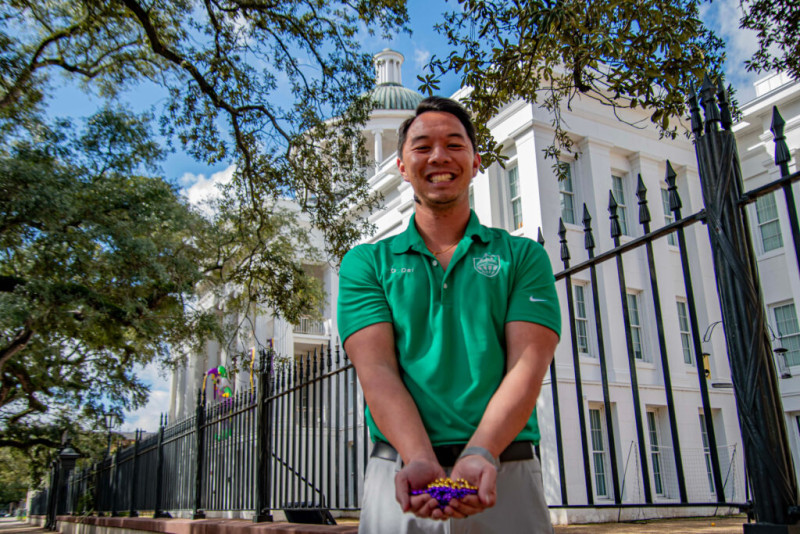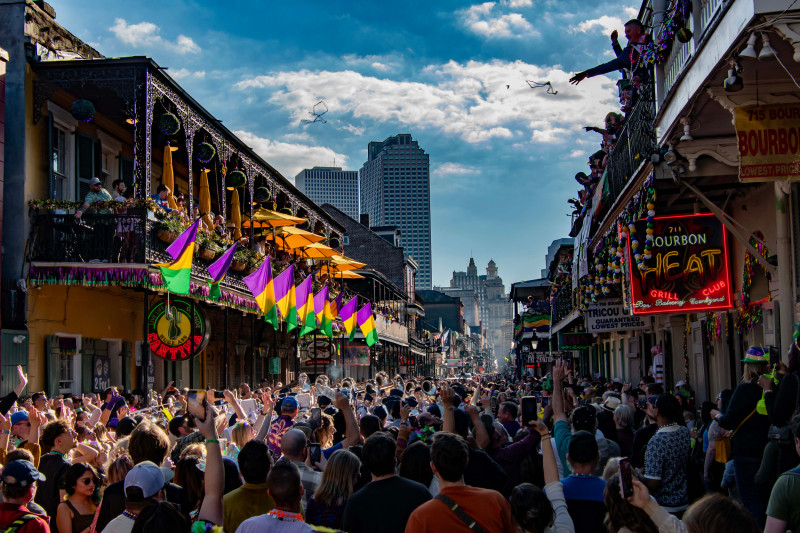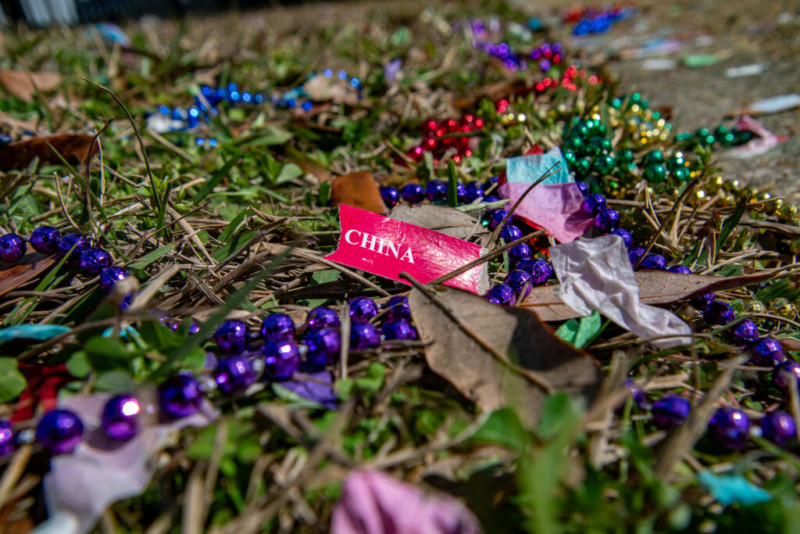During Mardi Gras, Tons of Fun Comes With Tons of Toxic Beads
MOBILE, Ala.—The trees tell the tale.
In the weeks before Lent, their branches begin to glisten in the late winter sunlight. The parades begin, and day after day, the beads make their landing, tangling themselves—purple, green and golden plastic—in often-bare limbs.
The streets speak, too.
As the good times roll at Mardi Gras, float by float, the throws filter through the crowd to the roads and sidewalks below—beads, trinkets and Moon Pies—covering the ground in a layer of rejected dreams, the pre-Lenten loot that didn’t quite make it into spectators’ plastic Piggly Wiggly bags and Winn-Dixie totes lining the miles-long parade route in the Gulf Coast city’s downtown.
Then an effort at cleanup begins. An army of city workers in neon vests a hundred strong marches down the street in a show of municipal force rarely seen in Southern cities. But on these days each year, the city makes a way out of no way. So, as the fleet of floats comes to an end, the workers disassemble the barricades that had held the crowds back from the parade route. Another crew follows with leaf blowers, pushing the debris from where the crowds had been minutes earlier, off the sidewalks and into the streets where the next step of the process would soon start.
We’re hiring!
Please take a look at the new openings in our newsroom.
See jobsNext, the jets come. White trucks, “hydroforce” painted across their side, spray water onto the debris now thickening in the roadways. The slurry of beads and baubles begins to shine under the streetlights. Streetsweeping trucks zip along the route, their drivers struggling to suck up the festering fun. It often isn’t enough. In the end, it’s city workers with boots on the ground who do the backbreaking work of the final walk. Pile by pile, they use shovels, brushes and rakes to cross the finish line. Nearly all the debris—in 2023, a total of around 300 tons of it—heads to the landfill. A similar brute force clean-up takes place 140 miles west in New Orleans.
The next day, it all begins again.
David Dai knows where this all leads.
Dai, a former Alabama high school teacher of the year, spends his days along Route A, teaching at Barton Academy, a public magnet school for grades 6-9.
He knows that Mardi Gras season is only the beginning. He knows that despite the brief, Herculean effort at cleanup, some beads will stay, their vibrant colors slowly dulling as they dangle from the oaks or linger in the storm drains. He knows that come next January, before a single parade rolls down Government Boulevard, the trees and streets will already tell the tale. He knows it needs to change.
Colorful plastic beads have become the most recognizable Mardi Gras throw across the Gulf Coast. The stringed beads, often sourced from China, can contain lead, heavy metals and other materials that can be toxic to humans, particularly children. Tens of millions of pounds of Chinese-made plastic beads are imported to the Gulf Coast for Mardi Gras annually, a cheap but vast loot of plastic throws that only increases in volume each year.
Dai is one of a growing number of Mobilians and New Orleanians envisioning a greener Mardi Gras. He thinks about it as he directs school traffic in the morning a block off the parade route, picking up broken beads and flattened, plastic-wrapped Moon Pies along the way.
“We need a transformation of tradition, a challenging of the status quo,” Dai said just outside the school in Mobile.
Barton Academy for Advanced World Studies, a relatively new magnet school, has attracted teaching talent from across the district and beyond. That recruiting effort brought teachers like Dai to Barton, which is housed in a renovated historic building that served as the first public school in Alabama and more recently was the home of the district’s central office.

Dai grew up in Bayou La Batre, Alabama, a small fishing town in south Mobile County where he’d moved from California with his parents, Vietnamese immigrants, in first grade. He grew up translating for his parents and their friends, explaining their bills and other documents to them when he could, even being the go-between at parent-teacher conferences. Dai said the experience made him understand the value of service early on—putting the community’s needs in front of his own.
It’s that kind of service, a shared commitment to making the community better, that he hopes can lead to the rebirth of Mardi Gras in Mobile and beyond. It’s why he’s running an elective course, new this year, where students plan to engineer a more eco-friendly design for the ubiquitous carnival bead.
In a 2020 statement, the Center for Environmental Health noted “growing concern” about the health hazards and the environmental cost of millions of pounds of plastic beads manufactured in China for Mardi Gras, many of which contain lead and flame retardants.
“While exposure to lead and flame retardants is harmful to everyone’s health, it’s particularly dangerous for children,” the center said, adding that, beyond these health effects, “the plastic beads end up in landfills or down storm drains, and contribute to the problem of plastic waste in our environment. In 2018, the City of New Orleans found 93,000 pounds of Mardi Gras beads in just 5 city blocks that had washed down into storm drains.”
The Ecology Center, based in Ann Arbor, Michigan, released a report in 2020 on the chemical hazards of Mardi Gras beads, concluding that most of the sampled throws contained bromine and antimony, suggesting the presence of brominated flame retardants and antimony trioxide, substances that can pose health risks.
“Most of these beads also contained levels of chlorine consistent with the presence of chlorinated flame retardants,” the report said. “One-third of the samples contained over 100 parts per million (ppm) lead, ranging as high as 472 ppm. 100 ppm is the limit allowed in children’s products in the United States.”
Research has also shown elevated levels of lead in soil located near parade routes in New Orleans, for example, posing an additional avenue of exposure to lead by adults and children alike.
“Lead poisoning is the number one environmental health threat to children ages six and younger in the U.S.,” according to the Louisiana Department of Health. “Research shows that lead exposure among young children can result in lowered intelligence, reading and learning disabilities, impaired hearing, reduced attention span, hyperactivity, and antisocial behavior. There is no safe level of lead in blood, and adverse health effects can occur at lower concentrations.”
The department has advised that during Mardi Gras, parents should help children take precautions like using hand wipes before they eat and after picking up beads on the ground and changing any clothing that may have been exposed to dirt along the parade route after the parade concludes.

Coming up with a suitable alternative to the omnipresent plastic bead throw is a big challenge for a small class, but Dai said it’s important that the conversation starts somewhere. The earlier students begin to think deeply about big issues that require big solutions, the better.
In his class, some of that conversation began with one student’s straightforward question: If the plastic throws are bad for the environment, why don’t we just stop?
“So we’ve had discussions about the tradition, how it’s customary,” Dai said. “In order to get people to stop, you really have to change behavior. And how do you do that for tens of thousands of people who have experienced Mardi Gras, with beaded necklaces as throws, for decades?”
Instead, David’s students have suggested, change may come more slowly, through gradual adoption of more sustainable throws one Mardi Gras organization at a time. The key to success, Dai said, is having students think about the factors that continue to lead paraders to choose plastic beads over alternatives.
“If we’re going to try and change the behavior of Mardi Gras organizations that purchase the beads,” Dai said, new products will be necessary that are safe and cost-efficient. If they can be developed, he said, “then I think we have a winner, and there’s potential for us to develop a prototype, plan and test that amongst the local organizations and see what we can do.”
Dai was able to secure initial funding for the project that will help the class to bring some of their ideas to life. Students will come up with Shark Tank-style pitches in groups, with the winning team’s idea being produced and pitched to local Mardi Gras organizations.
Even if their prototype isn’t the magic bullet, Dai hopes that having more people think about the impacts of Mardi Gras on the community and its environment is a good first step toward change. Without that change, Dai said, he worries about the future of carnival season.
“We live along the coast. We are a city that is threatened by hurricanes,” Dai said. With global warming, the coastline is constantly being threatened. Mardi Gras has been going on for a couple of centuries, and a couple of centuries from now, if we don’t think collectively about how we treat the environment, there might not be a Mobile to parade in.”
Dai isn’t the only educator concerned about Mardi Gras throws.
Mark Benfield is a professor of oceanography and coastal sciences at Louisiana State University. There, he works as a biological oceanographer, studying topics like microplastics’ impact on sea life.
Benfield said he went to a parade in Baton Rouge over the weekend.
“And I didn’t catch a single bead,” Benfield told Inside Climate News. “They have so much value when they’re flying through the air, but once they land, they usually just become trash.”

Though he isn’t a native Louisianan, the ecologist has become an expert on the environmental impact of Mardi Gras. The first time he experienced a carnival parade, he thought the implications would be straightforward.
“I thought the throws were all headed straight to the ocean. But the reality is, they’re denser than water,” he said. “So they sink. So they’re just in the stormwater system, just accumulating.”
The problems that follow range from simply aesthetic to much more sinister, Benfield explained.
With the impacts of climate change worsening flooding, in particular, coastal cities will face a greater strain on their stormwater infrastructure, particularly in low-lying cities like New Orleans and Mobile.
Then there are the impacts on the ecosystem. Once bead material begins to break down, introducing compounds like microplastics to stormwater, the potential for effects on humans or wildlife increases.
“It takes a long time for this stuff to degrade, and it’s easy for this stuff to get into the food web,” Benfield said. “It’s probably moving slowly along the bottom of the Mississippi River and our stormwater systems, getting pumped into the river and making its way towards the sea.”
Plastic debris has a history of causing marine fatalities in Alabama. In 2022, for example, scientists documented how a plastic bag obstructed the esophagus of a manatee in Mobile County, contributing to its death.
“We know that manatees can ingest and become entangled in debris,” said Elizabeth Hieb, the Manatee Sighting Network Manager at Dauphin Island Sea Lab. “Picking up throws and other debris during Mardi Gras, but also properly recycling or throwing away your trash any time, is important.”
Like Dai, Benfield thinks it’s unlikely Mardi Gras organizations will make the switch to eco-friendly throws overnight, though his colleague at LSU has worked on biodegradable beads as well. He understands the global behemoth the Mardi Gras industrial complex has become, from Middle Eastern oil fields to Chinese factories, all the way to the parade route. And, he admits, he doesn’t want to rain on anyone’s parade.
“I don’t want to have someone key my car or slash my tires because I’m saying Mardi Gras throws are an environmental problem,” Benfield said, a smile in his voice. “We want Mardi Gras to continue. It’s part of the region’s vitality. But we need to start thinking about more environmentally sound ways to deal with the throws.”
Ben Kaiser knows Mardi Gras. It’s painted all over his shirt.

The week before Fat Tuesday, the season’s biggest day, Kaiser is busy putting final touches on a fleet of Mardi Gras floats he’s worked to transform all year. A prominent local artist, Kaiser started Mirth Artists just out of college, a company devoted to float production and design. Since then, the work has been constant. This year, Kaiser and his colleagues were responsible for designing and producing dozens of floats for three organizations’ parades, working 11 months out of the year to make the Mardi Gras magic happen.
For him, Mardi Gras is about transformation. Each year, each organization’s floats, which can cost tens of thousands of dollars each, are shifted from one year’s theme to the next. Some floats are constants, simply requiring a paint touch up or a quick adjustment, but for others, the transformation is total.
“He used to be Elvis Presley,” Kaiser said. He gestures at a papier-mâché werewolf towering from the front of a float nearby. You’d never have known it.
Kaiser said he’s never understood the appeal of the Mardi Gras bead. His company isn’t involved with sourcing the throws that organizations stock their floats with, but as a parade-goer, he’s always preferred other throws anyway.
“I wish Moon Pies were placed in something paper, too,” he said.
In a season known for its indulgence, signs of careful reuse and recycling are scattered throughout the Conti Street float warehouse where Kaiser and his crew work. Old elements of floats line the walls, a patchwork of purple, green and gold ready to take on a new role when needed. On tables near the front, Arizona sweet tea jugs hold the crew’s paint.
“Eighty percent of a float is paper products,” Kaiser said.
Nearly all of that paper, he explained, is reused, picked up outside of local strip malls and Dollar Generals.
“We recycle as much as we can, just for my own sanity,” he said. “It would be hard for us to be completely carbon neutral, but we’re trying to do what we can.”
Like Dai, Kaiser said he thinks that thoughtful changes in the way the good times roll on the Gulf Coast could allow Mardi Gras to continue sustainably for generations to come.
“We can have fun and not ruin the planet,” Kaiser said. “It’s not rocket science.”
Kaiser is right. You don’t have to be a scientist. But William Strickland knows the science, too.
Strickland, the executive director of Mobile Baykeeper, earned a degree in environmental engineering at the University of Alabama while winning two national football championships under coach Nick Saban.
Much of Mardi Gras’ environmental impact comes from plastic waste associated with float throws, Strickland emphasized, trinkets that can be changed in design to be more eco-friendly.
“We should reduce our reliance on plastic, which is slow to break down and can create microscopic pieces that end up in our waterways and eventually our bloodstreams,” Strickland said. “People need to take throws home to reuse or make sure they end up in the trash; leaving litter and throws on the street is careless and causes much of the pollution that comes from Mardi Gras.”
During Mardi Gras 2023, the City of Mobile collected around 600,000 pounds of trash, all of which ended up in the nearby Chastang Landfill, where household garbage from the area is trucked year-round. A comparatively small amount—8,850 pounds of recyclable material and 2,153 pounds of beads specifically—was recycled by the city, though that amount is on the rise, according to Jason Johnson, deputy director of communications for the City of Mobile.
Johnson said that in partnership with Mobile Baykeeper, the city recently updated sewer grates in heavily trafficked areas of downtown, improving their ability to prevent throws from entering the stormwater system altogether.

“Mardi Gras definitely produces a lot of debris, but we try to mitigate that with a robust cleanup effort so that it’s properly disposed of,” Johnson said.
Two hours west in New Orleans, Brock Dogan drives Mardi Gras revelers around the city in his Tesla for Uber, weaving in and out of pedestrians and parade routes to get travelers and locals alike wherever it is they need to go.
Dogan moved to the United States from Turkey around six years ago, when he was 22. A software engineer, Dogan drives for Uber to meet people and make some extra cash. He said he’s undoubtedly cashing in from the tourism associated with carnival season, but he’s seen the experience as a unique opportunity to better understand why people are participating in what he sees as a troubling environmental blight.
Dogan said he attended a single Mardi Gras parade when he arrived in the city. He’ll never attend another.
“I couldn’t even do it twice,” he said. “The waste is disgusting. It’s interesting that it has religious origins. It’s not very holy to kill the next generation.”
Dogan said he spends a lot of time thinking about environmental issues. It’s the primary reason he bought a Tesla, he said—to lessen the carbon emissions caused by his side hustle.
“I don’t even remember what gas smells like, and I like that,” he said. “But imagine how much pollution this is causing.”
Dogan looks up at the road ahead, filled curb to curb with vehicles waiting on a break in the parade to make their way across.
Along with the plastic waste produced during Mardi Gras, carbon emissions caused by cargo shipping and passenger travel to the Gulf Coast are one of the season’s biggest sources of pollution. The towing of the floats themselves is also a notable source of emissions. While measures of the carnival’s economic impact are widespread, estimates of exactly how much carbon is emitted as a result of Mardi Gras season are more difficult to come by.
As Benfield pointed out, Mardi Gras’ environmental implications intersect with the effects of climate change. Just a few hours after Dogan shared his thoughts—with storm drains layered with stray beads and Moon Pies—much of New Orleans found itself underwater, its streets flooding quickly after a downpour of more than five inches of rain was exacerbated by clogged basins and a failure in the power system necessary to pump water out of the city.
Realities like that flooding—dangers of Mardi Gras compounded by climate-amplified precipitation and infrastructural instabilities—are dynamics that residents, environmentalists and city officials must mitigate.
Many in the South envision a greener future for Mardi Gras. Whether through biodegradable beads, recyclable floats, or electrified transportation, they believe the future of Mardi Gras will, for better or worse, be tied to the willingness of revelers to commit to a sustainable carnival season.
A unified effort at making that commitment, Dai said, may even help break down other barriers within the Mardi Gras culture, like the racial segregation that still grips carnival in the Port City.
“If we can start having these conversations, things can begin to shift,” Dai said. “Change trickles down. If we’re able to think about how to have a different Mardi Gras, maybe we can think about how to have different Mardi Gras societies. Maybe we can start to think about how to have a different society altogether.”
Share this article
Disclaimer: The copyright of this article belongs to the original author. Reposting this article is solely for the purpose of information dissemination and does not constitute any investment advice. If there is any infringement, please contact us immediately. We will make corrections or deletions as necessary. Thank you.






